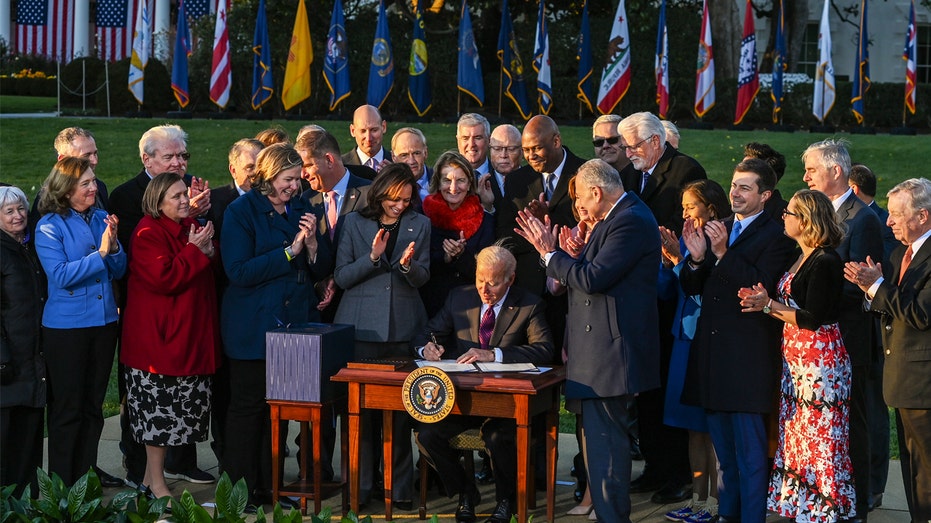Congress on track to spend $9T in under 2 years as Dems forge ahead with spending bill
Government spending surges to $7T over past 18 months
Transportation Secretary Buttigieg discusses $1.2T infrastructure bill
U.S. Transportation Secretary Pete Buttigieg discusses the infrastructure bill, impact of Democrats' spending bills on inflation, Biden's approval rating and the future of electric vehicles.
Democrats are forging ahead with plans to pass President Biden's signature economic spending plan that would unleash another torrent of federal money into the U.S. economy, despite anxiety over rising inflation.
The House could vote as soon as this week on a massive tax and spending bill that imagines spending $1.75 trillion over the next decade to bolster the social safety net and combat climate change.
The measure – which comes at an awkward time for Democrats, with inflation hitting a three-decade high in October – could push federal spending over the past 18 months to a stunning $8.85 trillion.

Lawmakers have already approved about $7.1 trillion in new spending since March 2020, including $5.9 trillion in pandemic relief measures, according to a money tracker published by the Committee for a Responsible Federal Budget, a nonpartisan organization based in Washington. About $4.8 trillion has already been spent or is earmarked for future use.
CONSUMER PRICES SURGE BY MOST IN 31 YEARS
Roughly $4.1 trillion of that money was passed with bipartisan support under former President Trump. Democrats singlehandedly approved another $1.9 trillion March with the passage of the American Rescue Plan.
And on Monday, Biden on Monday signed into law the $1.2 trillion bipartisan infrastructure bill. Thirty-two Republicans – 13 in the House and 19 in the Senate – joined most Democrats in voting for the bill. (Six progressives in the House voted no.)
The measure includes more than $500 billion in new spending that will be invested in "core" infrastructure projects such as roads, broadband internet and electric utilities over the next eight years. The White House has touted the measure as a "once-in-a-generation investment" and has projected that it will create 2 million new jobs.
But the package pushed spending levels in the U.S. over the past 18 months to more than $7 trillion, or roughly 30.6% of the nation's GDP, a level that is entirely without precedent.
To put that into perspective, the U.S. has spent roughly the same amount of money in the past 18 months than it did on every war across the world in the wake of the Sept. 11 attacks (about $6.4 trillion), according to one analysis conducted by Brown University's Watson Institute of International and Public Affairs.

During the 2008 financial crisis, for instance, the Obama administration approved a relief package roughly half the size of the American Rescue Plan, and a fraction of overall relief efforts this year and last. And President Franklin Delano Roosevelt's New Deal — arguably the biggest welfare push in modern U.S. history — would have cost have $653 billion in 2009, according to the St. Louis Federal Reserve.
The exorbitant level of spending caused the nation's deficit to surge to $2.77 trillion in 2021, the second-highest level on record. The highest level was recorded in fiscal year 2020, when the deficit hit a shocking $3.1 trillion.
INFLATION WILL LIKELY GET WORSE BEFORE IT STARTS IMPROVING, GOLDMAN WARNS
And even though the national debt is on track to exceed $30 trillion, Biden and congressional Democrats are plowing ahead with attempting to pass the president's nearly $1.75 trillion Build Back Better agenda as they seek to dramatically expand the government-funded safety net.
The newest "Build Back Better" proposal – pared down from the original $3.5 trillion request – would expand Medicaid, establish universal preschool, provide new funding for child care and offer green energy tax credits, though it notably omits progressive priorities like free community college and Medicare coverage of dental and vision. It relies on $1.95 trillion in new taxes, including a 15% corporate minimum and a surcharge aimed at ultra-millionaires.
"We pay for everything we spend," Biden said recently while speaking at the White House. "It’s going to be zero. Zero."





















